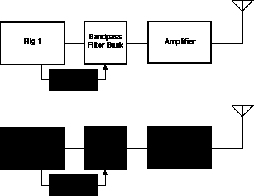DuneStar Model 600 Bandpass Filter Characteristics
Bob Wolbert, K6XX
The DuneStar 600 is a relay-selected bandpass filter array that allows operating two stations on different bands simultaneously-without blowing up your receiver front-ends. This model consists of six bandpass filters, one each for 160m, 80m, 40m, 20m, 15m, and 10m. The rigs transmit and receive through the proper bandpass filter, which 1), reduces wideband phase noise radiated from the active transmitter; and 2), prevents out-of-band power (and noise) from reaching the active receiver. A band select signal from the radio or a manual switch selects the correct operating bandpass filter. Coupled with the band select schemes described previously, the DuneStar filter array is completely transparent in operation. Besides its utility in protecting adjacent receiver's front ends, the filters also reduces TVI by a small amount (10dB to 20dB). Figure 1 shows the system block diagram of a dual-rig contest station employing auto-switching bandpass filters.

Figure 1. Block diagram of two radio contest station using automatically selected bandpass filters.
Filter Characteristics
The DuneStar 600 was evaluated with a HP 4396B Network/Spectrum analyzer. Table 1 summarizes the band-to-band rejection characteristics of the individual filters. Spectrographs for each bandpass filter follow.

